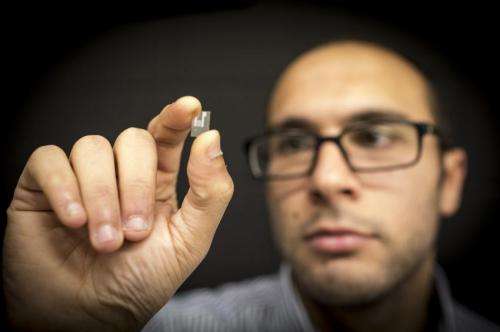Micro-manufacturing breakthrough is wired for sound

In a breakthrough discovery, researchers at RMIT University in Melbourne, Australia, have harnessed the power of sound waves to enable precision micro- and nano-manufacturing.
The researchers have demonstrated how high-frequency sound waves can be used to precisely control the spread of thin film fluid along a specially-designed chip, in a paper published today in Proceedings of the Royal Society A.
With thin film technology the bedrock of microchip and microstructure manufacturing, the pioneering research offers a significant advance – potential applications range from thin film coatings for paint and wound care to 3D printing, micro-casting and micro-fluidics.
Professor James Friend, Director of the MicroNano Research Facility at RMIT, said the researchers had developed a portable system for precise, fast and unconventional micro- and nano-fabrication.
"By tuning the sound waves, we can create any pattern we want on the surface of a microchip," Professor Friend said.
"Manufacturing using thin film technology currently lacks precision – structures are physically spun around to disperse the liquid and coat components with thin film.
"We've found that thin film liquid either flows towards or away from high-frequency sound waves, depending on its thickness.
"We not only discovered this phenomenon but have also unravelled the complex physics behind the process, enabling us to precisely control and direct the application of thin film liquid at a micro and nano-scale."
The new process, which the researchers have called "acoustowetting", works on a chip made of lithium niobate – a piezoelectric material capable of converting electrical energy into mechanical pressure.
The surface of the chip is covered with microelectrodes and the chip is connected to a power source, with the power converted to high-frequency sound waves. Thin film liquid is added to the surface of the chip, and the sound waves are then used to control its flow.
The research shows that when the liquid is ultra-thin – at nano and sub-micro depths – it flows away from the high-frequency sound waves.
The flow reverses at slightly thicker dimensions, moving towards the sound waves. But at a millimetre or more in depth, the flow reverses again, moving away.
More information: Double Flow Reversal in Thin Liquid Films Driven by MHz Order Surface Vibration, Amgad R. Rezk, Ofer Manor; Leslie Y. Yeo, and James R. Friend, Proceedings of the Royal Society A, 25 June 2014. rspa.royalsocietypublishing.or … .1098/rspa.2013.0765
Journal information: Proceedings of the Royal Society A
Provided by RMIT University


















